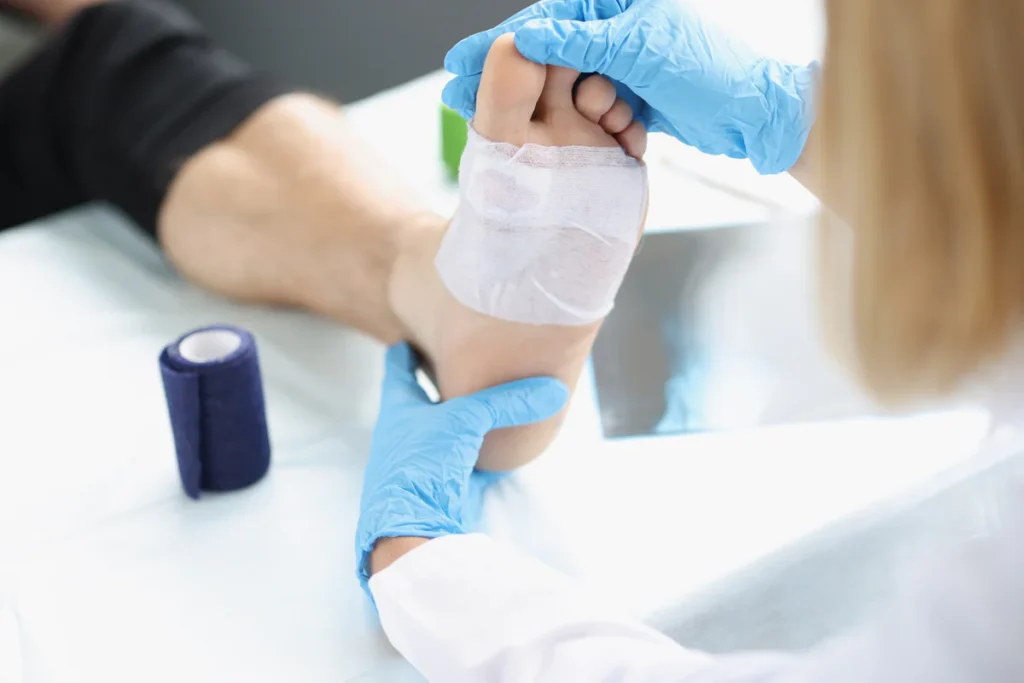Understanding Forefoot Ulcers
Forefoot ulcers are open sores or wounds that develop on the front part of the foot, often affecting the toes or the ball of the foot. They commonly occur in patients with diabetes, peripheral neuropathy, or poor blood circulation, making it difficult for the body to heal minor injuries. Patients may notice redness, swelling, pain, or even drainage from the ulcer, which can significantly affect mobility and quality of life. Neuropathy can make detecting these ulcers challenging, as some patients may not feel discomfort despite the severity of the wound. Additional risk factors include foot deformities, ill-fitting shoes, prolonged pressure on certain areas, and previous foot injuries. Early detection is critical to prevent the ulcer from deepening and spreading to surrounding tissues, bones, or joints. Recognizing these warning signs and seeking professional care promptly is essential for effective management.
Importance of Timely Orthopedic Intervention
Orthopedic care plays a pivotal role in managing forefoot ulcers and preventing complications that may lead to severe infections or even amputations. Delayed treatment can exacerbate tissue damage, prolong healing time, and increase healthcare costs. Orthopedic specialists evaluate the ulcer, assess the patient’s foot structure, and determine the most effective intervention tailored to the individual’s needs. Coordination with podiatrists, vascular specialists, and wound care teams ensures comprehensive management and minimizes risks. Orthopedic treatment not only focuses on healing the current ulcer but also addresses underlying biomechanical issues that may contribute to ulcer formation. Patients benefit from personalized care plans that incorporate both medical and lifestyle interventions. Timely intervention significantly improves recovery outcomes, reduces hospital stays, and enhances long-term foot health.
Types of Orthopedic Treatments for Forefoot Ulcers
Orthopedic treatments for forefoot ulcers are diverse and are chosen based on the ulcer’s severity, underlying causes, and patient-specific factors. One of the primary approaches is offloading, which reduces pressure on the affected area. This includes custom orthotics, specialized footwear, and total contact casting, all designed to distribute weight evenly and promote healing. Surgical options may be necessary for severe ulcers or underlying deformities. Procedures such as debridement remove dead tissue, while corrective surgeries address structural issues that increase ulcer risk. Advanced wound care techniques, including negative pressure wound therapy, growth factors, and skin substitutes, further support tissue regeneration. Infection management is crucial, often involving targeted antibiotics and regular monitoring to prevent complications. Combining these approaches ensures a holistic treatment plan that addresses both immediate and long-term needs.
Monitoring and Ongoing Care
Continuous monitoring is essential in orthopedic treatment for forefoot ulcers to ensure proper healing and prevent recurrence. Regular check-ups allow healthcare providers to track wound progress, adjust interventions, and address emerging issues promptly. Techniques such as wound measurement, photography, and tissue assessment provide objective insights into healing rates. Patients are educated on daily foot care practices, including proper hygiene, moisturizing, and inspecting for early signs of pressure or injury. Lifestyle adjustments, such as managing blood sugar levels, maintaining a healthy weight, and avoiding prolonged pressure on the feet, play a significant role in recovery. Orthopedic specialists often collaborate with caregivers to reinforce proper care routines and enhance adherence to treatment plans. Effective monitoring reduces the risk of complications and empowers patients to actively participate in their recovery journey.
Preventive Strategies in Orthopedic Practice
Prevention is a critical component of orthopedic care for patients at risk of forefoot ulcers. Early screening for high-risk individuals, especially those with diabetes or peripheral neuropathy, helps identify potential problems before they develop into ulcers. Protective footwear designed to redistribute pressure and cushion vulnerable areas can dramatically reduce ulcer formation. Orthopedic practitioners emphasize patient education, teaching techniques for safe walking, nail care, and skin inspection. Engaging patients in their own care plan ensures better adherence and long-term success. Additionally, periodic evaluations allow adjustments to footwear, orthotics, and offloading strategies to accommodate changes in foot structure or activity level. Preventive measures not only safeguard foot health but also reduce hospitalizations and healthcare costs. A proactive approach in orthopedic practice is the most effective way to maintain foot integrity and overall mobility.
Frequently Asked Questions (FAQ)
1. How long does orthopedic treatment for forefoot ulcers typically take?
The duration varies depending on ulcer severity, underlying conditions, and patient adherence to care. Mild ulcers may heal within a few weeks, while more complex cases can take several months. Consistent follow-up and adherence to offloading and wound care strategies are critical to successful healing.
2. Can custom orthotics completely prevent ulcer recurrence?
While custom orthotics significantly reduce pressure and support foot alignment, they may not entirely prevent ulcers. Regular monitoring, proper footwear, and lifestyle adjustments are essential to minimize recurrence. Orthotics are most effective when used in combination with comprehensive foot care practices.
3. What are the risks associated with surgical interventions for forefoot ulcers?
Surgical procedures carry risks such as infection, delayed wound healing, and recurrence if underlying causes are not addressed. Proper preoperative evaluation and postoperative care are vital to minimize complications and improve recovery outcomes.
4. Are there non-surgical alternatives for severe forefoot ulcers?
Yes, non-surgical treatments like total contact casting, negative pressure wound therapy, and advanced wound dressings can be effective for certain severe ulcers. The choice depends on ulcer depth, patient health status, and response to conservative interventions.
5. How can patients monitor their own healing process at home?
Patients should inspect their feet daily for changes in color, size, or discharge. Taking photos to track progress, maintaining proper hygiene, and reporting any signs of infection to a healthcare provider ensures timely intervention. Regular home monitoring complements professional care and enhances healing outcomes.

